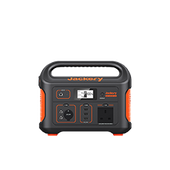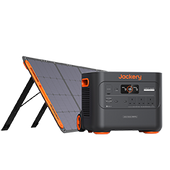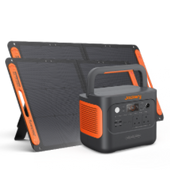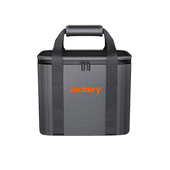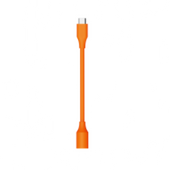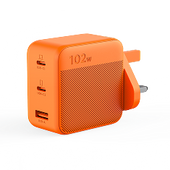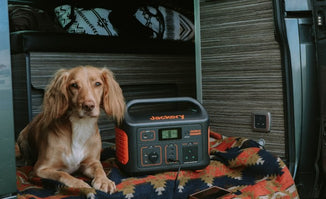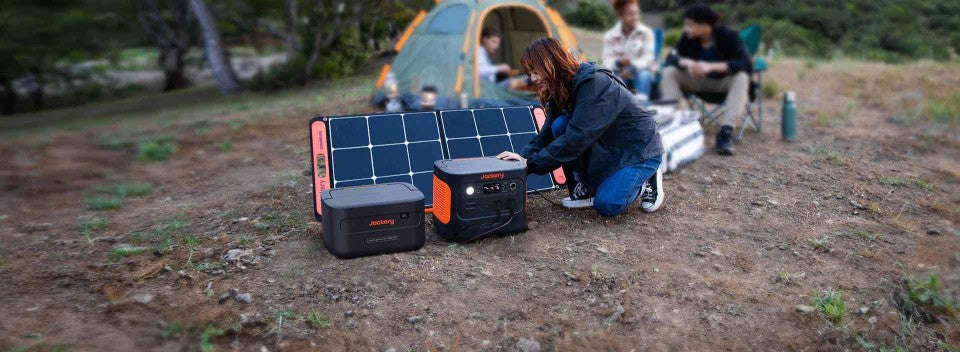Sudden power cuts are annoying because they disrupt people's daily lives. So, what causes power cuts? Sometimes, power cuts are due to unforeseen weather conditions; sometimes, they are caused by maintenance work or unexpected faults.
A power cut is when electricity, especially the grid or electric network, is unavailable. Power cuts usually affect an entire area, not just one home. So, knowing how to check for power cuts in your area is far more critical.
Also, we suggest you invest in a Jackery Solar Generator to charge your household appliances in an emergency. You can even bring it inside your home because it doesn't make any noise or give off any pollution.
|
Key Takeaway |
|
l Circuit overloads, equipment failures, natural disasters, human error, and scheduled maintenance are the most common causes of power cuts. l You can heck for power cuts in your area through case analysis, distribution network operators, and social media. l In the UK, you can report power cuts by calling 105 or contacting the distribution network operator. l The appropriate measures taken before the power cut will likely help you get through the difficult times. l When there is a power cut in your area, you can choose a Jackery Solar Generator 1000 Plus or 2000 Plus to charge essential appliances. |
Why Do Power Cuts Happen?
Why do power cuts happen? Are you facing a power outage and don't know why? Nationwide power outages are rare in the UK these days. However, localised power outages still occur from time to time, usually due to the following reasons:
Circuit Overload
Circuit overload is the most common cause of power outages. Circuit overload occurs when too many appliances draw power from the same circuit. Of course, when the demand for electricity peaks, the grid becomes overloaded, and power outages occur.
Equipment Failure
Equipment failure is another common cause of power outages, such as a blown fuse, a tripped circuit breaker or a faulty power strip. No equipment is entirely immune to problems or failures. So technical faults or equipment failures at power stations, substations or lines are also the leading causes of power outages. When equipment fails, it disrupts the power supply chain. The power supply will be affected unless the same technical fault is resolved.
Natural Disasters
Lightning strikes, floods and fallen trees can cause damage to cables and equipment. Unforeseen weather events also cause power outages, including heavy snow, storms, lightning strikes and strong winds. Often, severe weather conditions damage power lines, substations and other infrastructure, ultimately disrupting the electricity supply.
Although the UK has been fortunate not to suffer from the same natural disasters as other parts of the world, flooding is still the leading cause of many power outages in the UK.
Human Error
There are many situations where human error can cause a power outage, including working too close to power lines or even road accidents. So, cable damage could be caused by a contractor or someone digging in the garden and hitting a cable.
In addition to some of the most basic human errors that can cause a power outage, other human causes include:
- Fire or theft
- International power trading that causes the system to be overloaded
- War
- Cyberattacks
- Nuclear accidents
Scheduled Maintenance
Like rolling blackouts, the power is sometimes temporarily disconnected to protect workers doing essential maintenance work. Power outages caused by scheduled maintenance are usually short-lived, as many maintenance services try to carry out their work at a time that will cause minimal disruption.
Types of Power Cuts in The UK
A power cut is when electricity, especially the grid or electric network, is unavailable. Power cuts usually affect an entire area, not just one home. Generally speaking, there are four central power outages: blackouts, brownouts, permanent faults, and rolling blackouts.
|
Types of Power Cuts |
Impact Level or Scope |
Repair Difficulty or Time |
|
Blackouts |
A complete loss of power to an area. |
Difficult to repair quickly and may last for days or weeks. |
|
Brownouts |
Causing equipment to degrade or not function. |
Moderately complex to repair. |
|
Permanent Faults |
A sudden loss of power caused by a faulty power line. |
Easily repaired. |
|
Rolling Blackouts |
A planned long or short power outage. |
It takes time to repair. |
Blackouts: A blackout is the most severe type of outage when an area lacks power. Blackouts are usually caused by severe damage to the power generation facility (such as structural damage caused by a severe storm or lightning strike) and are challenging to repair quickly. Blackouts can last for days or even weeks.
Brownouts: A brownout is a voltage or total power supply drop to a building or area. While brownouts don't cause a complete power outage, they can cause equipment to degrade or not function. For example, some appliances, such as electric ovens, may not operate at a lower voltage during an outage because they are designed to operate at a higher voltage.
Permanent Faults: A permanent fault is a sudden loss of power, usually caused by a fault in a power line. Permanent faults are easy to repair and typically don't cause a broader impact on the entire area because permanent faults are usually caused by problems with the power supply mechanism, which are generally easy to find and repair.
Rolling Blackouts: Rolling Blackouts differ from other power outages because they are planned long or short-term. Rolling Blackouts are often implemented in areas with failures or instability in the power grid and power infrastructure, so Rolling Blackouts are more of a precautionary measure.
Rolling blackouts can also occur if there is insufficient fuel to run the power at total capacity, whether short-term or long-term.
How to Check for Power Cuts in Your Area?
Is there a power cut in your area today? If there is a planned power outage in your area, the distribution network operator will contact you and let you know.
However, sometimes a power outage may occur due to unforeseen problems. How can you check if there is a power outage in your area? If you don't have electricity and want to know if there is a power cut in your area, you can check it as follows:

Tip 1: Check by Yourself
Please judge by yourself whether there is a power outage based on the following:
- Check if the street lights are on or there is power in your neighbour's house.
- Check the fuse box to make sure all switches are turned on.
- If you use a pay-as-you-go meter, ensure you have enough electricity credit.
Tip 2: Contact Your Distribution Network Operator
Each area has a dedicated distribution network operator, and you can call them directly using the contact information below. In addition, you can check the power outage situation on the distribution network operator's website.
The following table shows the contact information of each distribution network operator in the UK:
|
Distribution Network Operator |
Areas Covered |
Phone Numbers |
|
North West England |
0800 195 4141 |
|
|
Midlands, South West England and South Wales |
0800 6783 105 |
|
|
York, Leeds, Sheffield, Northern Lincolnshire and Yorkshire |
0800 66 88 77 |
|
|
Northern Scotland |
0800 300 999 |
|
|
Central Southern England |
0800 072 72 82 |
|
|
Cheshire, Merseyside, North Wales & North Shropshire |
0800 001 5400 |
|
|
Edinburgh, Glasgow, Central & Southern Scotland |
0800 092 9290 |
|
|
London, South East and East of England |
0800 31 63 105 |
How do you identify the distribution network operator in your area?
Please use the following three methods to identify the distribution network operator in your area:
- Please distinguish according to the coverage area in the table above.
- Please distinguish according to the DNO distribution map in the figure below.
- Website lookup.

(Data Source: energynetworks)
If you want an easier way to find out who your local Distribution Network Operator (DNO) is, enter your postcode on the Energy Networks Association website to find out who your DNO is.
Tip 3: Call 105
Call 105 to get the latest news about power cuts. In the UK, various websites provide real-time information about power outages in your area, especially the handy 105 website.
Tip 4: Contact Your Distribution Network Operator
In this day and age, you will get all the valuable information on social media. So you can check Twitter for the latest news about power cuts.
Here are the Twitter accounts of the UK's various distribution network operators:
|
Distribution Network Operator |
|
|
Electricity North West |
@ElectricityNW |
|
National Grid |
@gridcustomersuk |
|
North Power Grid |
@Northpowergrid |
|
Scottish and Southern Electricity Networks |
@ssencommunity |
|
SP Energy Networks |
@SPEnergyNetwork |
|
UK Power Networks |
@UKPowerNetworks |
How to Report A Power Cut in Your Area?
While the UK's electricity system is highly reliable and resilient, power cuts (blackouts) can happen for several reasons.
The first thing to do after a power outage is to report the outage to your electricity supplier. Distribution network operators are usually responsible for restoring your home and business power. So, reporting a power cut will help the maintenance crew to help you get your power back on. But how do you report a power cut to a distribution network operator?
When a power cut occurs in your area, you must first check if anyone around you is also experiencing a power cut. Once you've identified an unexpected power cut, here's how to report it:
- Call 105
If you're experiencing an unexpected power cut, you can call 105 to report it and get information about the power outage in your area. Why call 105 when a power cut occurs?
When a power cut occurs, dial 105 (free) from your mobile or landline, transferring you to your local operator's emergency number. Of course, if you find that power lines and substations are damaged and may put you or others in danger, you can also call 105.
- Contact the Distribution Network Operator (DNO)
Please get in touch with the corresponding distribution network operator (DNO) using the information mentioned above to learn about the latest power cuts in your area.
How to Prepare for A Power Cut?
Although your electricity provider does everything possible to maintain your electrical equipment, power outages can still happen. However, power cuts can happen anytime, so knowing what to do when a power cut occurs is essential. You want to avoid being caught in a power cut, so it's best to prepare in advance. Your steps before a power cut will help you get through it.

Step 1: Make An Emergency Plan
An emergency plan is the first step in dealing with power cuts. Your power-cut emergency plan should include the following:
- How do you contact family and friends in an emergency?
- What should you include in your emergency kit?
- How to prepare your pets for a power outage.
- How do you prepare for a power outage for a family member who needs medical care?
Step 2: Protective Measures
Because power cuts can affect home appliances when power is restored, protective devices can also reduce the risk of damage after a power cut. So you should install surge protectors in advance to protect sensitive electronic equipment such as TVs, DVD players, and computers.
No matter how old or new the house is, its weaknesses can become apparent when the power goes out. It's important to carefully check your home to find places that could be damaged during an electricity blackout.
This could include places that are dangerously dark, with no artificial lighting or rooms that depend too much on electric air and get stuffy when the power goes out in the summer. Think about other things outside the house, like trees that could fall on power lines or how close it is to flood zones.
Know where your home's main circuit breaker is and how to turn it off in an emergency. Ensure any outdoor furniture or equipment is securely secured, and move your car to a sheltered location if possible.
Step 3: Power Cut Emergency Kit
Prepare a power cut kit with lighting (such as flashlights), emergency food (such as cereal, bread, and dairy alternatives), and medical supplies (such as hemostatic dressings and disinfectants). It is best to place a power cut emergency kit in a designated area that is easily accessible during a power outage.
Lighting: Place battery-powered flashlights and spare batteries in every room of your home. Try not to use flammable lighting such as candles.
Emergency Food: Cereals, breads, and alternative dairy products are good choices. Canned foods require a can opener. Please replace items promptly according to shelf life.
First Aid Kit: Prepare a kit, including common medications, hemostatic dressings, disinfectants, etc.
The following is a checklist for a power cut kit:
|
Power Cut Emergency Kit |
||
|
Communication Equipment |
Flashlight |
Canned Food |
|
Important Documents |
Candle |
Sealed Dry Food |
|
Cash |
Matches |
Bottled Water |
|
Spare Key |
Battery |
Pet Food |
|
Hygiene Products |
Radio |
Pet Vaccination Records |
|
First Aid Supplies |
Back Power |
Warm Goods (Cooling Goods) |
|
Entertainment Supplies |
|
|
Step 4: Medical Care
Talk to your doctor about a plan for when the power goes out for medical devices that use electricity and meds that need to be kept cold. Find out how long medicines can be kept at higher temperatures and get specific advice for any needed medication.
A lot of our gadgets, like CPAP machines, home ventilators, and continuous oxygen monitors, need to be charged with energy. Because of this, preparing your home medical device to keep treating you even if the power goes out is essential.
|
Medical Devices |
Amps |
Hours |
Power Needed |
|
CPAP Machine |
55A |
8H |
440Ah |
|
Home Ventilator |
2.6A |
8H |
20.8Ah |
|
Oxygen Monitor |
1A |
12H |
12Ah |
|
Blood Pressure Meter |
0.5A |
0.2H |
0.1Ah |
After gathering your home medical device's details, examine how a power outage can affect it. Then, you can consider investing in a portable power supply, like Jackery Solar Generator 1000 Plus and 2000 Plus, to charge your medical devices safely at home.
Step 5: Prepare for Pets
If you have pets, keep a photo of you and your pet to prove ownership. It would help if you also made the following additional power-cut preparations for your pet:
- Prepare extra food for your pet.
- Keep your pet's vaccination records and rabies vaccination tags.
Step 6: Backup Power
Backup power can provide temporary power during power cuts and keep essential appliances and equipment running. So consider investing in a backup power source, such as a portable power bank or solar generator. The Jackery Solar Generators are options you can consider. Of course, you must also understand how to operate and maintain a backup power source safely.
Jackery Solar Generators for Power Cuts
The Jackery Solar Generator can be used as a backup power source if the power goes out, making life much easier when you don't have control.
Jackery is a renowned manufacturer in the solar industry, focusing on producing top-notch solar equipment like solar generators, solar panels, and portable power stations. Jackery Solar Generators offer a reliable and uninterrupted power supply for your household appliances.

When there is a power outage, the Jackery Solar Generator 2000 Plus and Jackery Solar Generator 1000 Plus will keep you and your family running. Both comprise SolarSaga solar panels and portable power stations from the Explorer series.
The Jackery Solar Generator 1000 Plus has an expandable capacity of 1.25-5 kWh battery, which can power 99% of your household appliances.
Besides, the Jackery Solar Generator 2000 Plus has a battery that can be expanded from 2 kWh to 12 kWh. For this reason, the Jackery Solar Generator 1000 Plus and 2000 Plus are better choices for extra power at home.
|
Home Appliances |
Working Hours |
|
|
Solar Generator 1000 Plus |
Solar Generator 2000 Plus |
|
|
Fridge (350W) |
3-12H |
4.7-29.1H |
|
Lighting (25W) |
42.5-170H |
65.3-408H |
|
TV (60W) |
17.7-70.8H |
27.2-170H |
|
Phone (10W) |
106.3-425H |
163-1020H |
|
Stove (750W) |
1.4-5.7H |
2.2-13.6H |
Jackery Solar Generator 2000 Plus
Jackery has unveiled the Solar Generator 2000 Plus, a cutting-edge portable power solution with exceptional performance. Thanks to its substantial capacity and formidable power output, this device can sustain the operation of standard domestic appliances for several weeks and fulfil all the power needs associated with outdoor adventure or professional activity.
The Jackery Solar Generator 2000 Plus allows adding extra battery packs, which boosts the capacity from 2 kWh to a remarkable 12 kWh, thus enhancing the solar charging capabilities significantly. With the ability to be expanded to 3000W, this solar product offers a 30% higher rated power than other 2 kWh solar goods available in the market.
The Explorer 2000 Plus is an industry's pioneering add-on battery pack that can be recharged using solar panels. This feature enhances versatility, improves charging efficiency, and reduces charging time. The LiFePO4 battery, with its sophisticated technology, guarantees a lifespan of 10 years, even with daily usage limited to once per day.
- Expandable Capacity: 2 kWh large capacity with up to 12 kWh extended power elevates off-grid living to the next level.
- Ultra-Long Standby: Out of sight, out of mind. The 2000 Plus has an ultra-long standby mode with a 50% charge for up to 2 years!
- Fast Solar Charging: The Solar Generator 2000 Plus takes just 2 hours for a total solar charge (with 6* SolarSaga 200W solar panels). Power source becomes fully independent.

Jackery Solar Generator 1000 Plus
The Jackery Solar Generator 1000 Plus is the best portable power supply for power cuts. It combines Jackery Explorer 1000 Plus with SolarSaga 100W solar panels to use solar energy effectively.
Featuring a 2000W full-power pure sine wave inverter and a stunning 1264Wh long-lasting LiFePO4 battery, the Explorer 1000 Plus offers abundant energy for almost all essential devices. Remarkably, it can increase its capacity to 5 kWh by incorporating up to 3 additional battery packs.
It takes 100 Mins for a wall charge (from 0 - 100% of battery) and 2 hours of solar charging with 4 SolarSaga 200W solar panels. Additionally, the innovative ChargeShield technology and consistent power delivery avoid equipment damage.
- Higher Capacity with Smaller Size: With a capacity of 1264 Wh and a 2000W output, the 1000 Plus has the maximum output among similar-level products, supporting 99% of devices.
- Expandable Capacity: Up to 5 power levels, providing three days of home emergency backup. Versatile for outdoor, household, and emergency scenarios.
- Battery Safety: Boasting a durable 10-year lifespan with a Lithium Iron Phosphate (LiFePO4) Battery, the Jackery 1000 Plus provides a constant voltage and pure sine wave, ensuring safety for all your electrical appliances.

How to Stay Safe During A Power Cut?
Power cuts are often unpredictable, meaning they can happen at any time. And power cuts can happen unexpectedly and disrupt daily life. Therefore, taking measures to maintain daily life and protect your family's safety during power cuts is essential.
Stay Updated: Constantly monitor your electricity supplier for information about power outages. For example, check your electricity supplier's power outage map during severe weather. In addition, you can also receive information about power outages on the radio or mobile phone.
Turn off All Electrical Appliances: Turn off all electrical appliances, especially electric heaters and cooking appliances, during power cuts for your safety. The risk is the same whether the power cut lasts a few minutes or days.
Food Safety: During power cuts, keep the refrigerator or freezer door closed, which will help keep the temperature as low as possible. (Low temperatures help keep food fresh.) In addition, the time of the power cut should be recorded to estimate whether the food is safe.
Check for Power Cuts in Your Area FAQs
The following are the frequently asked questions about how to check for power cuts in your area.
- Why can't the UK's national grid generate enough electricity?
The UK's electricity grid is one of the most reliable in the world. However, the UK is not yet self-sufficient in electricity generation. While renewable energy is essential in the UK's electricity generation industry, the weather is uncontrollable. Moreover, energy demand is always higher in winter.
- When will a planned emergency power cut happen?
In general, a planned emergency power cut is unlikely to happen, and it is difficult to predict precisely when it will happen. However, many variables could lead to a planned emergency power cut. For example, the following situations:
- Lack of wind reduces available energy.
- Continued cloudy weather reduces solar energy.
- If temperatures drop sharply and the government and national grid cannot import enough electricity from Europe.
- What do you doif you encounter a power outage?
An unexpected power outage may cause panic or distress or disrupt your everyday life. Therefore, staying calm and following the correct steps is essential to resolve the problem quickly. Follow these steps when you encounter a power outage:
Step 1: Turn off all electrical appliances that cannot be left unattended to reduce the risk of damage.
Step 2: Leave a light on so you know when the power is restored.
Step 3: Check the main switchboard to see if the circuit breaker has tripped.
Step 4: If the weather is cold, wrap up tightly and close the inner doors to keep the room warm.
Step 5: Using gas and diesel generators can be dangerous, so use a solar generator.
Step 6: Contact your electricity supplier to report the power outage.
Final Thoughts
As with anything, the UK's network distribution operators work hard to maintain and repair the electricity system when a power cut occurs in their area. However, power cuts happen occasionally due to natural disasters, accidents or equipment failures.
In short, power cuts are often unexpected, but there are ways to prepare for them. You can make emergency plans, organise supplies, prepare a Jackery Solar Generator, and ensure safety measures before a power cut occurs.









